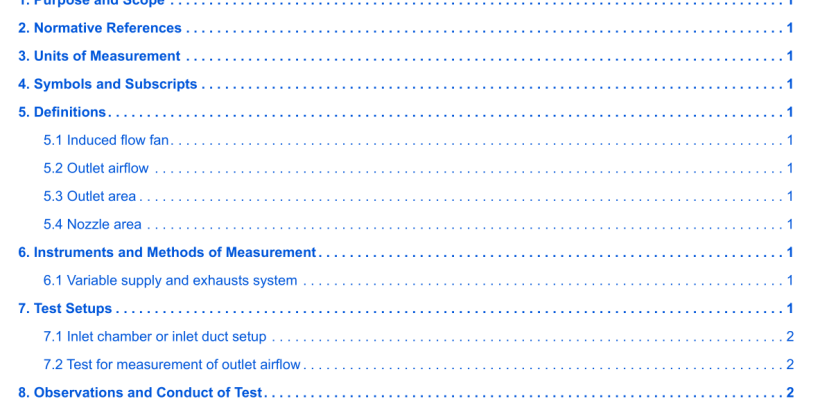ANSI AMCA 260-2013 pdf download.Laboratory Methods of Testing Induced Flow Fans for Rating
1. Purpose and Scope
The purpose of this standard is to establish a uniform labo- ratory method for determining an induced fow fan’s aerody- namic performance in terms of airfow rate, pressure devel- oped, power consumption, air density, speed of rotation and effciency. This standard is an adjunct to ANSI/AMCA 210 in order to accommodate the induced fow fan’s unique characteristics. It is not the purpose of this standard to specify the testing procedures to be used for design, production or feld testing. The scope of this standard is limited to induced fow fans, as defned below. The parties to a test, for guarantee purposes, may agree on exceptions to this standard in writing prior to the test. However, only tests which do not violate any mandatory requirements of this standard shall be designated as tests conducted in accordance with this standard.
2. Normative References
The following standard contains provisions which, through reference in this text, constitute provisions of this standard. At the time of publication, the edition indicated was valid. All standards are subject to revision, and parties to agreements based on this standard are encouraged to investigate the possibility of applying the most recent edition of the stan- dard indicated below. ANSI/AMCA 210: Laboratory Methods of Testing Fans for Aerodynamic Performance Rating
3. Units of Measurement
All units used in this standard are defned in ANSI/AMCA 210. The primary units are SI units (The International System of Units (Le Systéme International d’Unités), with I-P (inch- pound) units given as the secondary reference.
4. Symbols and Subscripts
All symbols and subscripts are defned in ANSI/AMCA 210 with the following addition. For an induced fow fan, there are two planes of exit. Where the main (inlet) fow exits the nozzle, the outlet plane will preserve the ANSI/AMCA 210 defnition of plane 2. The plane at the end of the wind band will be identifed by a subscript “9”. Thus the average veloc-ity at the exit of the nozzle is identifed as V 2 , and the aver- age velocity at the exit of the wind band is identifed as V 9 .
5. Defnitions
All defnitions are given in ANSI/AMCA 210 with the follow- ing additions:
5.1 Induced fow fan
An inducted fow fan is a housed fan whose outlet airfow is greater than its inlet airfow due to induced airfow. Those induced fow fans under the scope of this standard will include a nozzle and a windband. All of the fow entering the inlet will exit through the nozzle. The fow exiting the windband will include the nozzle fow plus the induced fow.
8.1 Data recording requirements for the outlet airfow test as defned in Section 7.2
Torque or other means of determining input power is not required for this test. Chamber static pressure P s7 is main- tained at zero for this test and need not be recorded. The resistance box pressure P t8 and temperature t d8 must be recorded. In lieu of a total pressure tube, a piezometer ring can be used to measure static pressure at plane 8. If this alternate arrangement is used, and the calculated plane 8 velocity is greater than 2 m/s (400 fpm), then the calculated plane 8 velocity pressure (a positive value) shall be added to the measured static pressure (a negative value). Calculation of the plane 8 velocity pressure requires the inlet fow rate as determined in the inlet chamber (or inlet duct) test, the area in plane 8, and the density in plane 8. The duct piezom- eter formulae given in ANSI/AMCA 210 can be used, except plane 8 is substituted for plane 4.ANSI AMCA 260-2013 pdf download
